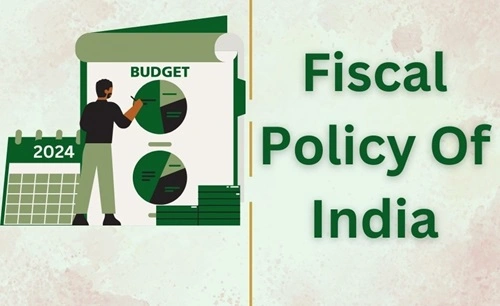Fiscal policy is a critical tool in managing a nation’s economy, involving government decisions on taxation, public expenditure, and borrowing to influence economic growth and stability. In India, fiscal policy plays a pivotal role in steering the economy toward development, equity, and sustainability. This article delves into the advantages and disadvantages of fiscal policy in India, providing a comprehensive understanding of its impact.
Understanding Fiscal Policy in India

Fiscal policy in India is shaped by the Union Budget, presented annually by the Ministry of Finance. The policy is categorized into:
- Expansionary Fiscal Policy: Used during economic slowdowns, it involves increased government spending and reduced taxation to stimulate demand and growth.
- Contractionary Fiscal Policy: Implemented during inflationary periods, it reduces spending or increases taxes to curb excess demand.
India’s fiscal policy aims to achieve multiple objectives:
- Economic growth: By allocating resources to key sectors such as infrastructure, education, and healthcare.
- Redistribution of wealth: Through progressive taxation and welfare programs.
- Price stability: By controlling inflation and ensuring affordability.
- Employment generation: By promoting job-creating industries and sectors.
Advantages of Fiscal Policy in India
1. Economic Growth Stimulation
Fiscal policy is a powerful driver of economic growth in India. Through increased public expenditure on infrastructure, education, healthcare, and technology, the government can stimulate economic activity. For example, initiatives like Make in India and infrastructure development projects have attracted investments, boosted productivity, and fostered industrial growth.
2. Reduction in Income Inequality
The progressive taxation system in India, where higher-income groups pay higher taxes, helps in redistributing wealth. Welfare schemes such as MGNREGA (Mahatma Gandhi National Rural Employment Guarantee Act) and Direct Benefit Transfers (DBT) ensure that the economically weaker sections receive financial aid, thereby reducing income inequality.
3. Control of Inflation
During periods of high inflation, the government can adopt contractionary fiscal measures, such as reducing public expenditure or increasing taxes. These actions help curb excessive demand and stabilize prices. For instance, excise duty adjustments on fuel are used as a tool to manage inflation.
4. Employment Generation
Fiscal policy in India is often targeted at creating jobs. Investment in labor-intensive industries, infrastructure projects, and rural development programs generates employment opportunities. Policies like Skill India Mission are aimed at enhancing employability.
5. Boosting Private Sector Growth
By providing subsidies, tax incentives, and grants, fiscal policy encourages private sector investment. For example, tax holidays for startups under the Startup India initiative have helped foster innovation and entrepreneurship.
6. Addressing Regional Disparities
Special economic packages and targeted development projects for backward regions, such as the North-East Region or aspirational districts, help bridge the gap between developed and underdeveloped areas.
7. Crisis Management
During crises such as the COVID-19 pandemic, fiscal policy plays a vital role in stabilizing the economy. Measures like stimulus packages, cash transfers, and tax relaxations during the pandemic supported businesses and individuals, preventing a deeper economic downturn.
8. Encouragement of Savings and Investment
Fiscal measures such as deductions under Section 80C of the Income Tax Act encourage savings and investment among individuals. This strengthens the capital market and supports long-term economic growth.
Disadvantages of Fiscal Policy in India
1. Fiscal Deficit
India has struggled with high fiscal deficits, which occur when government expenditure exceeds revenue. Persistent deficits can lead to excessive borrowing, increasing the debt burden. As of FY 2023-24, India’s fiscal deficit target is set at 5.9% of GDP, which, though lower than earlier years, remains significant.
2. Inefficiency in Resource Allocation
Fiscal policies often suffer from inefficient allocation of resources due to bureaucratic delays, corruption, and poor implementation. Subsidy leakages in schemes like PDS (Public Distribution System) have historically hindered the effectiveness of such policies.
3. Inflationary Pressures
While fiscal policy can control inflation, excessive government spending can lead to inflationary pressures. For instance, subsidies on fuel, fertilizers, and food items, while politically popular, can strain the fiscal budget and contribute to inflation.
4. Crowding Out of Private Investment
Large-scale government borrowing to finance fiscal deficits can lead to higher interest rates, making it difficult for private businesses to secure affordable credit. This phenomenon, known as “crowding out,” hampers private sector growth.
5. Dependency on Tax Revenue
India’s fiscal policy is heavily reliant on tax revenue, which can be volatile due to economic fluctuations. A slowdown in economic activity reduces tax collections, constraining government spending. For example, the GST collection during the early months of the pandemic saw a sharp decline.
6. Regional Imbalances
Despite efforts to address disparities, fiscal policy sometimes leads to uneven development. Politically influenced resource allocation often favors certain regions, leaving others underserved.
7. Short-Term Focus
Fiscal policies in India are often influenced by electoral considerations, leading to a short-term focus on populist measures rather than long-term structural reforms. For instance, farm loan waivers, while beneficial for farmers, strain state budgets and discourage credit discipline.
8. Limited Fiscal Space
India’s high debt-to-GDP ratio limits the government’s ability to implement expansive fiscal policies. With limited fiscal space, the government struggles to meet the growing demands of infrastructure, defense, and welfare programs.
9. Tax Evasion and Compliance Issues
India faces significant challenges in ensuring tax compliance. A large informal economy and widespread tax evasion reduce the effectiveness of fiscal measures. Despite efforts to widen the tax base through reforms like GST, the compliance rate remains a concern.
10. Impact on External Accounts
Excessive fiscal deficits can lead to an increase in imports due to higher domestic demand, thereby worsening the current account deficit (CAD). This was evident during periods of high oil imports, which strained India’s external accounts.
Balancing Fiscal Policy: The Way Forward
To maximize the benefits and minimize the drawbacks of fiscal policy, India must adopt a balanced approach:
- Enhanced Fiscal Discipline: Reducing wasteful expenditures and improving efficiency in resource allocation are crucial. The government should adhere to the fiscal deficit targets set by the FRBM Act (Fiscal Responsibility and Budget Management Act).
- Tax Reforms: Widening the tax base, improving GST compliance, and curbing tax evasion will strengthen revenue streams. Simplifying the tax structure can further encourage compliance.
- Public-Private Partnerships (PPPs): Leveraging private investments for infrastructure and public services can reduce the burden on public finances while improving project efficiency.
- Targeted Subsidies: Transitioning from universal subsidies to direct benefit transfers ensures that financial assistance reaches the intended beneficiaries, reducing leakages.
- Investment in Human Capital: Increased spending on education, healthcare, and skill development will enhance productivity and foster long-term economic growth.
- Strengthening Governance: Transparent governance and accountability mechanisms will reduce corruption and improve the implementation of fiscal policies.
Conclusion
Fiscal policy is a cornerstone of India’s economic strategy, influencing growth, equity, and stability. While it has the potential to drive economic transformation, challenges like fiscal deficits, inefficiencies, and political influences must be addressed. By focusing on fiscal discipline, tax reforms, and targeted spending, India can harness the full potential of fiscal policy to achieve sustainable and inclusive development.

